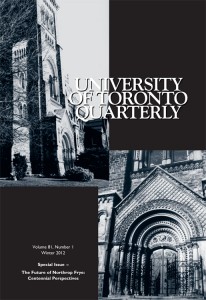The Editor Spotlight is a monthly feature which introduces readers to the forces behind our journals. Based on their own experience, editors answer questions which provides insight into their background, responsibilities, and the process of editing an academic journal.
November’s Editor Spotlight will be Simon Stern, a guest editor of The University of Toronto Quarterly‘s upcoming special issue on Law and Literature.
Simon Stern
Guest Editor of The University of Toronto Quarterly
1. Could you briefly explain what your role as a Guest Editor of The University of Toronto Quarterly entailed?
In working on the special issue on Law and Literature, three of us (Professors Cheryl Suzack and Greig Henderson, on the English faculty, plus myself) worked together to solicit contributions. Each of us read all of the contributors’ drafts and we shared our comments and suggestions, and then wrote up a response which we sent to the authors. The whole process took about 8 months.
2. How did you get started in this field?
I have been doing research in law and literature since graduate school. I wrote my PhD thesis on eighteenth-century English fiction and the historical and intellectual origins of copyright law. Then I attended law school, and become even more interested in the interconnections between law and literature. Some of the scholarship in this area emphasizes the role of literature as a means of drawing on human individuality or empathy to ameliorate law’s harshness or rigidity. Others see the two fields as akin because they both involve the interpretation of texts. Neither of these approaches seemed very satisfying. The first view, which assumes that it’s the job of literature to cure a legal problem, depends on reductive ideas about the value of literary texts and about the capacities of legal writing. The second view, involving a shared interpretive task, assumes that legal analysis is primarily about interpretation, and finds a common ground for law and literature that accounts for only a small part of what connects the two areas. I’ve been more interested in the ways in which literary devices (such as plot structure, technical means of handling narrative perspective, and conceptions of character) relate to legal methods of problem-solving, and the ways in which legal devices (such as multi-part tests or exclusionary rules) relate to literary models of explanation. This approach focuses more on the historical relations between the two fields, and it focuses on the ways in which we often acquire techniques and explanatory models implicitly, without necessarily becoming aware of it. I see both fields as influencing each other at least as much on an implicit level, as when they both address similar topics, such as inheritance disputes.
3. As an editor, how do you go about selecting topics, and authors, for chapters within an edited volume?
Cheryl, Greig, and I wanted to cover a range of topics and approaches, and we also wanted to include a range of people, including some well-known senior scholars and some less-established but brilliant young academics. For a successful collection of essays, it’s just as important to include newer scholars, because their work helps to ensure that the volume has something distinctive to offer that readers might not find elsewhere.
4. What are the qualities you look for in an article, and how do you maintain quality?
The question is what kind of work the article will foster. Many articles do an excellent job of answering the question they have posed, after framing the question so narrowly that the answer is unlikely to produce anything further. A strong article approaches a familiar subject in an unfamiliar way, or displays a method that could yield new insights when extended to other areas, and as a result it sparks new ideas and leads readers to think again about what they already know.
5. What are you current research interests?
I am currently doing some research on legal fictions, a concept that has attracted lots of discussion but is widely misunderstood. People often use the term as if it applies specifically when the law uses language that calls attention to its own fabrications (e.g., “constructive eviction”), but this view carries the odd (and extremely unpersuasive) implication that the rest of the time, the law does not depend on invention or imagination. I have also been working for several years with a group of legal historians on a scholarly edition of Blackstone’s Commentaries (1765-69), which will be published by Oxford University Press. Although it is one of the classic texts in the Anglo-American legal tradition, there has never been a scholarly edition. Wilfrid Prest (Univ. of Adelaide), the leading expert on Blackstone, is the editorial director of the project, and we expect to have the edition completed in 2015. Finally, I am doing some further research on the history of copyright law, looking specifically at eighteenth-century conceptions of copyright as a personal right (like the right against self-incrimination or the right not to be libeled) rather than as a property right, which provides the usual framework for understanding copyright law today.
Acclaimed as one of the finest journals focused on the humanities, the University of Toronto Quarterly publishes interdisciplinary articles and review essays of international repute. This interdisciplinary approach provides a depth and quality to the journal that attracts both general readers and specialists from across the humanities.
UTQ Subscribers look forward to the bi-lingual ‘Letters in Canada’ issue, published each spring, which contains reviews of the previous year’s work in Canadian fiction, poetry, drama, translations and works in the humanities. Many of the recent issues have contained over 600 pages of the year’s work in creative writing and scholarship!


Comments on this entry are closed.